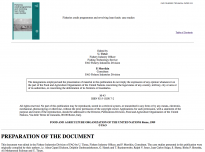Services and Infrastructure
Reducing delays and bottlenecks in value chains will help prevent food loss and waste (FLW). Reducing and preventing FLW will be more likely achieved in environments and locations which have the required services and infrastructure that enable fishers, processors and traders to leverage skills and knowledge needed to move product efficiently and effectively. This includes the proper use of equipment, proper handling and appropriate processing of fish, fast and efficient transportation of fish to market, and meeting the required regulations and legislative standards on handling, hygiene, quality, and food safety.
Infrastructure that promotes FLW prevention includes modern and well-designed fish landing centres, harbours, processing establishments, and markets, which are easily accessible by roads. Services include potable water, electricity, ice, fish inspection and extension services, and other public services such as environmental health inspection and market management. The obligation to provide many of these facilities and services is often on the public sector, or public-private partnerships. Services such as the provision of packaging materials and equipment, ice plants and cold stores are often managed effectively by the private sector, or through a private-producer organization.
For example, a reliable electricity supply will enable ice plants, freezers and cold stores to function and enable value-added processing methods and packaging to be used. Well-resourced and motivated public services, such as fishery inspectorates and extension services, will be better able to perform their duties and make sure that standards are being met and capacity building conducted effectively.
Finally, effective management and maintenance are also crucial to services and infrastructure.
Key Publications
Included is an overview of the use of ice for chilling and storing fish, including a review of fish spoilage and the technical and economic viewpoints of ice manufacturing and storage equipment. | |
Fishing Harbour Planning, Construction and Management This manual provides a handy reference and the means for integrating Hazard Analysis and Critical Control Points (HACCP) and European Union Directive recommendations on hazard-free seafood directly into the fishing port’s design. | |
Fisheries Credit Programmes and Revolving Loan Funds: Case Studies A series of case studies on successful fisheries credit programs and revolving loan funds are reviewed. |




